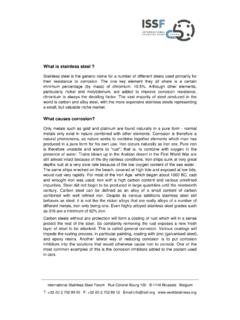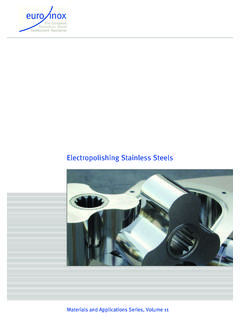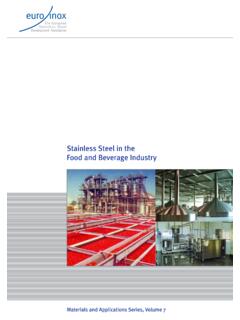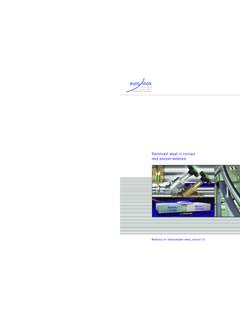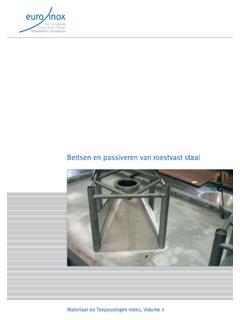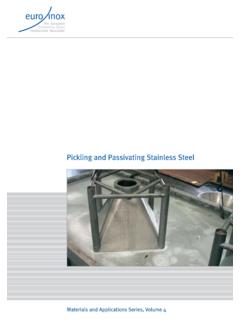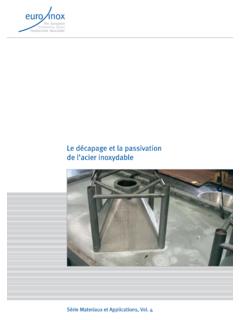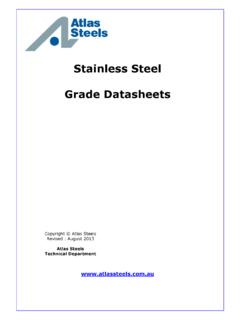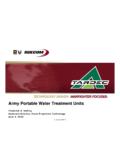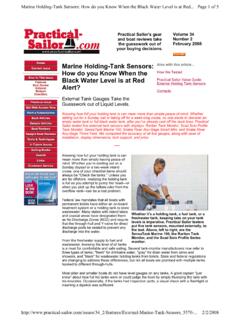Transcription of ISSF Stainless Steel in Drinking Water Supply
1 Stainless Steel in Drinking Water SupplyISSF Stainless Steel IN Drinking Water Supply - 2 ContentsWhy Stainless Steel in Drinking Water Supply ? Water intakeWater storageDistributionSummaryISSF Stainless Steel IN Drinking Water Supply - 3 Why Stainless Steel in Drinking Water Supply ?Its inert and corrosion-resistant nature makes Stainless Steel an ideal material for contact with Drinking Water in all stages from extraction to domestic plumbing. Stainless Steel is the only metallic material that is suitable for any usual Drinking Water the Drinking Water delivered by waterworks has defined contents of chlorides and other corrosive constituents, the original feed Water is much less predictable. From ground Water to sea Water , there is a wide range of compositions.
2 Whatever the corrosion challenge, the wide range of Stainless Steel grades provides solutions. For pipework and tanks , standard grades of the 306 and 316 families are by far the most usual grades; however, super austenitic and duplex grades can even defy the corrosive conditions that are found in the seawater intakes of desalination plants. Besides corrosion resistance, the mechanical properties of Stainless Steel make them attractive for Water applications. The ductility of Stainless Steel is an asset. In contrast to brittle materials like ceramics or cast iron, austenitic Stainless Steel can absorb considerable deformation without breaking. This is an advantage in seismic conditions. Duplex Stainless steels combine a high level of corrosion resistance with exceptional strength, which can be used to reduce wall thicknesses of tanks and pipes sometimes by 30 %.
3 For mechanical parts like valve balls, hard martensitic grades ensure long-term reliable the fabricator, formability and weldability are important. Austenitic Stainless steels are among the most malleable volume engineering materials. They are formable enough for tubes to be shaped into bellows, which serve as compensators for thermal expansion or absorb seismic movements. The outstanding weldability of most standard grades makes it easy to weld components on site, where conditions are more difficult to control than in a workshop environment. Stainless Steel surfaces can be made very smooth to reduce the adherence of particles and micro-organisms. Cleaning is possible by simple mechanical means. Applied protective coatings, which become susceptible to deterioration over time, can be dispensed with because the bulk material is intrinsically corrosion resistant.
4 Photo: Aqua-met, Mainstockheim (Germany), Stainless Steel IN Drinking Water Supply - 4 Water intakeFor the direct extraction of feed Water from the Water table, rivers and lakes or for the use of river bank filtrate, tubular Stainless wedge-wire filters are a common option. They consist of V-shaped profiles, which are welded onto transverse supports. Not only does this design lend stiffness to the filters, it also provides non-clogging properties. The filter can efficiently be cleaned mechanically or by Water extraction, Stainless Steel wedge-wire filters hold back coarse particles. The smooth Stainless Steel surfaces make it more difficult for micro-organisms to survive than on materials which are porous. Stainless Steel is biologically inert and does not release contaminants into the Water or ground.
5 The filters can easily be cleaned, which, together with their longevity, makes Stainless Steel solutions particularly intake filter made from Stainless Steel wedge : Sanya Wedge Wire Factory (PR China), for river beds. Source: Euroslot Kdss (UK), ISSF Stainless Steel IN Drinking Water Supply - 5 Water preparationStainless Steel is a standard option for pipes in waterworks. Also the outer surface remains corrosion-free over time without the need for applied protective layers, which are vulnerable, can age and eventually can be custom-made to meet the needs of specific process technologies. The photo below shows fabrications for a hydrogen sulphide removal facility. The fabricator used an automated, high-deposition submerged arc process to weld all circumferential and longitudinal seams on the pipe.
6 The pipe was 100 percent X-ray tested with no failures and was passivated with citric acid solution. It was delivered in 80-ft. sections, with additional 90-degree elbows. Picture above: Pipework for the hydrogen sulphide removal stage of waterworks. Source: Dixie-Southern Duelle, Fla (USA), Pictures below: Type 316 Stainless Steel for the City of Lake Worth reverse osmosis Water treatment plant. Source: Mock & Roos (USA), ISSF Stainless Steel IN Drinking Water Supply - 6 Stainless Steel in municipal waterworks. Source: Schenke Anlagenbau, (Germany), Stainless Steel in a typical mixed-material installation can be combined with coated Steel and cast iron parts provided the connections are properly designed and the flow direction is taken into : Wasserverband S dliches Burgenland (Austria), ISSF Stainless Steel IN Drinking Water Supply - 7 Water storageWater can be stored in underground reservoirs, Water towers or free-standing tanks .
7 In the project shown below, two tanks with a capacity of one million litres each were spiral-welded on site. It took about one month for them to reach their final height of nine metres. The tanks are housed in a wooden building, which blends nicely with the surrounding landscape. However, there is primarily a technical reason for this design. In contrast to conventional buried concrete tanks , the structural function and the Water -containment function are separated. This principle makes it possible to inspect and, if necessary, repair them independently of one another. Potential future work on the building can be performed without emptying the reservoirs. As the Stainless Steel tanks are essentially maintenance-free, the life-cycle cost of this solution is expected to be lower than for the integrated concrete design.
8 Stainless Steel is also used for the cladding Spiral-welded Stainless Steel reservoirs erected on site. Source: Bayerische Staatszeitung / Wasserversorgung Bayerischer Wald (Germany), of concrete underground reservoirs and Water towers. This technique has become an established refurbishment solution. Grade 316L is a proven option for this application. Conventional concrete reservoirs age; their surfaces crack and need to be coated periodically. Repair coatings on damaged surfaces, however, tend to develop blisters and other defects. In contrast, a welded, continuous Stainless Steel skin is durable and hygienic. Stainless Steel is insensitive to permanently wet conditions. This is not only important for the Water contact side; also the rear of the Stainless Steel skin, which is in contact with the concrete and exposed to a poorly ventilated space between the two materials, requires a high level of corrosion resistance.
9 Stainless Steel linings of concrete reservoirs. Source: Pre-fabricated and custom-made units are available for smaller reservoirs in locations, which are difficult to access. Stainless Steel doors have an additional safety function and efficiently protect the reservoir access against hooliganism and Stainless Steel units are also available for small installations. Source: Harasser (Austria), Stainless Steel IN Drinking Water Supply - 8In Japan, modular tanks have been made from Stainless Steel since the 1970s. One of the reasons is the excellent behaviour of Stainless Steel in earthquakes, when the elasticity and ductility of the material absorb shocks without the material breaking or cracking. Even in catastrophic situations, Drinking Water is not lost and continues to be available.
10 The wall elements of Stainless Steel modular Water tanks are strengthened by beads. They provide the required stiffness and keep wall thickness to a minimum. Modules can be combined into tank units of nearly any geometry square, rectangular, L or U shaped. Sizes of up to 3,000 m have been manufactured. Good long-term experience led to this design principle being used also in other countries. Modular Water tank system made from stiffened Stainless Steel panels. Photo: Morimatsu (Japan), Stainless Steel IN Drinking Water Supply - 9 DistributionStainless Steel is also an ideal material for the distribution of Drinking Water . In most environments, Stainless Steel is corrosion resistant to the ground and concrete. However, where the ground contains corrosive substances like chlorides or stray currents are present, it is recommended to apply an additional PE contrast to ceramic materials and cast iron, Stainless Steel is exceptionally ductile.

